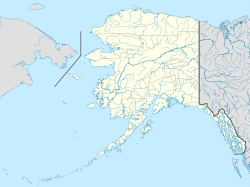Adugak Island (also spelled Adougakh, possibly from Aleut: Adudak;[1] (Unangam Tunuu: Adugax̂) is a small island in the Fox Islands group in the Aleutian Islands of southwestern Alaska. It is about 1.2 miles (2 km) long and is located 5.0 miles (8 km) off the northwest coast of Umnak Island.
Name
editThe name was recorded in 1840 by Ivan Veniaminov. It may arise from the word "Adudak", which means "somewhat long".[2]
Geography
editThe island about 1.2 miles (2 km) long and is located 5.0 miles (8 km) off the northwest coast of Umnak Island. It reaches an elevation of about 102 feet (31 m) above sea level and the area around the island is extremely hazardous to ships because of the numerous rocks that lie just below the surface of the water.[3]
Wildlife
editThe island has been protected as a rookery for the endangered Steller sea lion,[4] which has been observed during the winter feeding on the fish that inhabit the water nearby.[5]
Cassin's auklet once lived in the area, but disappeared. They also disappeared from other Aleutian islands such as Keegaloo, and Ilak Island due to introduced predators, oil spills, and mortality from fisheries interactions.[6]
Some animals on the island were tested positive for Polydnavirus, along with Yunaska.[7]
References
edit- ^ Bulletin - United States Geological Survey. United States Geological Survey. 1906. Retrieved 2008-09-22.
- ^ Geological Survey Professional Paper. U.S. Government Printing Office. 1949.
- ^ U.S. Coast and Geodetic Survey (1916). United States Coast Pilot: Alaska. Part II. Yakutat Bay to Arctic Ocean. US Govt. Printing Office. p. 216. Retrieved 2008-09-22.
adugak island.
- ^ "US Code - 50 CFR Ch. II - Subpart B - § 223.202 - Steller sea lion". United States Federal Government. Retrieved 2008-09-22.
- ^ Sinclair, Elizabeth. "SEASONAL AND SPATIAL DIFFERENCES IN DIET IN THE WESTERN STOCK OF STELLER SEA LIONS (page 8)" (PDF). National Marine Mammal Laboratory. Archived (PDF) from the original on 21 September 2008. Retrieved 2008-09-22.
- ^ "Alaska Seabird Information Series" (PDF). Alaska Region Migratory Bird Management. United States Fish and Wildlife Service.
- ^ VanWormer, Elizabeth (2019). Viral emergence in the North Pacific may be linked to Arctic sea ice reduction. University of Nebraska-Lincoln. p. 7.
52°54′17″N 169°10′28″W / 52.90472°N 169.17444°W
